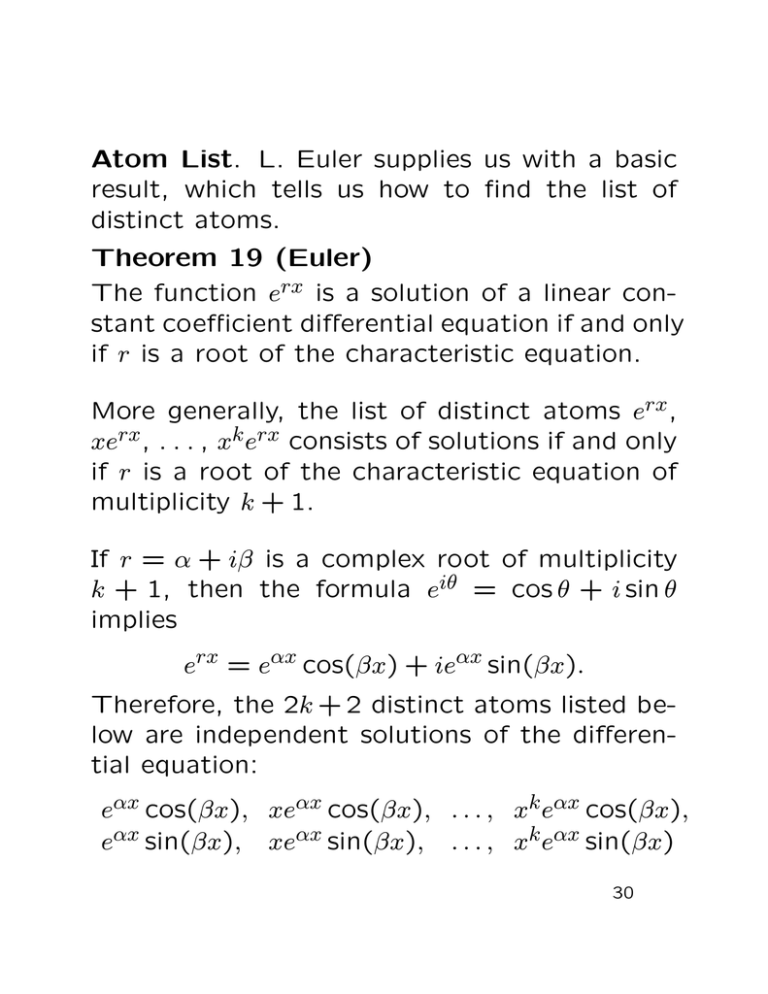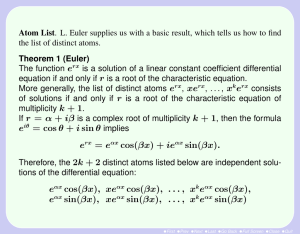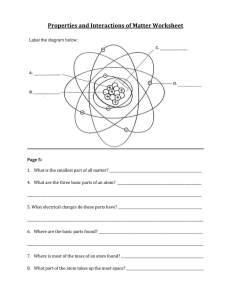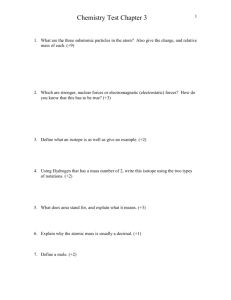Atom List. L. Euler supplies us with a basic distinct atoms.
advertisement

Atom List. L. Euler supplies us with a basic result, which tells us how to find the list of distinct atoms. Theorem 19 (Euler) The function erx is a solution of a linear constant coefficient differential equation if and only if r is a root of the characteristic equation. More generally, the list of distinct atoms erx, xerx, . . . , xk erx consists of solutions if and only if r is a root of the characteristic equation of multiplicity k + 1. If r = α + iβ is a complex root of multiplicity k + 1, then the formula eiθ = cos θ + i sin θ implies erx = eαx cos(βx) + ieαx sin(βx). Therefore, the 2k + 2 distinct atoms listed below are independent solutions of the differential equation: eαx cos(βx), xeαx cos(βx), . . . , xk eαx cos(βx), eαx sin(βx), xeαx sin(βx), . . . , xk eαx sin(βx) 30 1 Example (First Order) Solve 2y ′ + 5y = 0 by using the nth order recipe, showing yh = c1e−5x/2 . Solution: The characteristic equation is 2r + 5 = 0 with real root r = −5/2 and corresponding atom erx given explicitly by e−5x/2. Euler’s Theorem was applied here. The order of the differential equation is 1, so we have found all atoms. The general solution yh is written by multiplying the atom list by constants c1, c2, . . . , and therefore yh = c1 e−5x/2. 31 2 Example (Second Order I) Solve y ′′ + 2y ′ + y = 0 by using the nth order recipe, showing yh = c1e−x + c2xe−x. Solution: The characteristic equation is r2 + 2r + 1 = 0 with double real root r = −1, −1. Euler’s Theorem applies to report atom list erx, xerx , given explicitly by e−x , xe−x . The order of the differential equation is 2, so we have found all atoms. The general solution yh is written by multiplying the atom list by constants c1, c2 , . . . , and therefore yh = c1 e−x + c2 xe−x . 32 3 Example (Second Order II) Solve y ′′ +3y ′ + 2y = 0 by using the nth order recipe, showing yh = c1e−x + c2e−2x. Solution: The characteristic equation is r2 + 3r + 2 = 0 with distinct real roots r1 = −1, r2 = −2. Euler’s Theorem applies to report atom list er1 x, er2x , given explicitly by e−x , e−2x . The order of the differential equation is 2, so we have found all atoms. The general solution yh is written by multiplying the atom list by constants c1, c2 , . . . , and therefore yh = c1 e−x + c2 e−2x . 33 4 Example (Second Order III) Solve y ′′+2y ′+ 5y = 0 by using the nth order recipe, showing yh = c1e−x cos 2x + c2xe−x sin 2x. Solution: The characteristic equation is r2 + 2r + 5 = 0 with complex conjugate roots r1 = −1 + 2i, r2 = −1 − 2i. Euler’s Theorem applies to report an atom list eαx cos βx, eαx sin βx, where α = −1, β = 2 are the real and imaginary parts of the root α + iβ = −1 + 2i (then α = −1, β = 2). The atom list is given explicitly by e−x cos 2x, e−x sin 2x. The order of the differential equation is 2, so we have found all atoms. The lesson: applying Euler’s theorem to the second conjugate root −1−2i will produce no new atoms. The general solution yh is written by multiplying the atom list by constants c1 , c2 , . . . , and therefore yh = c1 e−x cos 2x + c2 e−x sin 2x. 34 5 Example (Third Order I) Solve y ′′′ − y ′ = 0 by using the nth order recipe, showing yh = c1 + c2ex + c3e−x. Solution: The characteristic equation is r3 − r = 0 with real roots r1 = 0, r2 = 1, r3 = −1. Euler’s Theorem applies to report atom list er1x , er2x , er3 x given explicitly by e0x , ex , e−x . The order of the differential equation is 3, so we have found all atoms. The general solution yh is written by multiplying the atom list by constants c1 , c2 , . . . , and therefore yh = c1e0x + c2 ex + c3e−x . Convention dictates replacing e0x by 1 in the final equation. 35 6 Example (Third Order II) Solve y ′′′ − y ′′ = 0 by using the nth order recipe, showing yh = c1 + c2x + c3ex. Solution: The characteristic equation is r3 − r2 = 0 with real roots r1 = 0, r2 = 0, r3 = 1. Euler’s Theorem applies to report atom list er1x , xer1x , er3x given explicitly by e0x , xe0x , ex. The order of the differential equation is 3, so we have found all atoms. The general solution yh is written by multiplying the atom list by constants c1, c2 , . . . , and therefore yh = c1 e0x + c2 xe0x + c3 ex . Convention dictates replacing e0x by 1 in the final equation. 36 7 Example (Fourth Order) Solve y iv − y ′′ = 0 by using the nth order recipe, showing yh = c1 + c2x + c3ex + c4e−x. Solution: The characteristic equation is r4 − r2 = 0 with real roots r1 = 0, r2 = 0, r3 = 1, r4 = −1. Euler’s Theorem applies to obtain the atom list er1x , xer1 x , er3x , er4x , given explicitly by e0x , xe0x , ex , e−x . The order of the differential equation is 4, so we have found all atoms. The general solution yh is written by multiplying the atom list by constants c1 , c2 , . . . , and therefore yh = c1e0x + c2xe0x + c3 ex + c4e−x . Convention replaces e0x by 1 in the final equation. 37







